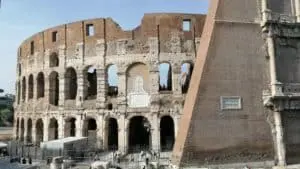Cultural Significance of Celtic Knotwork: Symbols of Infinity and Unity

Updated On: April 28, 2024 by Maha Yassin
Celtic knotwork is an intricate design with historical and cultural significance that has endured centuries. Originating from the early Celts, these ornate patterns were primarily used to decorate religious texts, monuments, and jewellery. Their designs are distinctive for their endless interwoven lines, symbolising eternity and the interconnectedness of all things. The precise origins are often debated, but they’re widely recognised as a symbolic representation of the artistic skills of the ancient Celts.
The symbolism associated with Celtic knots is vast and varies according to different interpretations. To some, they represent the intricacies of nature, while to others, they embody spiritual beliefs and the infinite cycle of life and death. These knots have been adopted and adapted throughout history, with their use prevalent in Christian manuscripts such as the Book of Kells, signifying a melding of cultural beliefs. In modern culture, Celtic knots continue to be a popular motif in art, fashion, and design as a visual link to the rich heritage of the Celtic people.
Early Origins and History
Before delving into the intricate story of Celtic knots, let’s set the scene with the early origins and background that has led to their enduring legacy.
Celtic Culture and Society
The Celts were a collection of tribes with origins deep in early European history. They were known for their languages, traditions, and vibrant art, greatly influencing their modern identity. Unlike the clear-cut boundaries of modern nations, the Celtic tribes were spread out and culturally diverse, often intermingling and sharing customary practices.
Influence of the Roman Empire
The interaction between the Roman Empire and the Celts was significant in history. It led to profound changes in Celtic society, including adaptations in art and craft. Roman classical forms meshed with existing Celtic traditions, prompting an artistic evolution later seen in the distinctive knotwork we associate with Celtic art.
Migration and Evolution
As the Celts migrated throughout Europe, their art and symbolism evolved. The knots, perhaps as simple patterns, transformed into today’s complex and symbolic designs. Through migration and the passage of time, these knots became emblematic of rich Irish heritage and the interconnectedness and continuity of life, capturing a piece of history that would journey far beyond its origins.
Symbolic Interpretations
In exploring the cultural impact of Celtic knots, we uncover a tapestry woven with deep symbolic value. These intricate designs are far more than mere decorative elements; they house a multitude of meanings and spiritual significance.
Meanings of Celtic Knots
Celtic knots embody the concept of eternity with their endless loops and no clear start or end. Historically, they represent the interconnectedness of life’s continuous cycle. Various knots, such as love, unity, and faith, carry different sentiments. For instance, the Trinity Knot is often associated with a woman’s three life cycles about the moon’s phases. In modern interpretations, it has also come to symbolise the Holy Trinity in the Christian faith.
Religious and Spiritual Significance
Celtic knotwork is tightly linked to the religious and spiritual realms. Its frequent appearance in Christian monuments and manuscripts reveals its adoption into Christian symbolism, whereby the endless knots signify the unwavering, eternal nature of God’s love. In broader spirituality, these knots can illustrate the bond between the physical and spiritual realms, reflecting the unity between earthly and celestial journeys.
Celtic Knot Designs and Patterns
Celtic knot designs encapsulate a rich heritage of intricate, interwoven patterns, each with symbolic meanings deeply rooted in Irish culture. These designs vary in complexity and form, embodying spiritual and historical significance represented by their ceaseless lines.
The Trinity Knot
The Trinity Knot, or the Triquetra, is one of the simplest yet most profound Celtic knot designs. Comprised of three interlocked arcs, it signifies concepts in triadic harmony, such as the elements of air, water, and earth or the past, present, and future. In Christian contexts, it has been adapted to symbolise the Holy Trinity.
The Dara Knot
Drawing from the Irish word for oak tree, ‘dair,’ the Dara Knot represents inner strength, wisdom, and power. Its intricate design resembles the complex root system of the oak tree, linking it to the resilience and stability inherent in nature.
The Celtic Cross
The Celtic Cross combines the traditional Christian cross with a ring surrounding the intersection. Its design is often enriched with detailed Celtic knotwork. This emblem not only signifies faith but also conveys the unity of the divine and the worldly within the endless loops of the knots.
The Shield Knot
The shield knot is an ancient symbol. Historically used for protection and to ward off evil spirits, it is usually square in shape and contains four distinct corner areas. It has been used in battle emblems and amulets to invoke the shield of protection from the ancestors.
Artistic Manifestations
Celtic knots are not merely decorative; they represent the Celts’ artistic and spiritual legacy. From ancient manuscripts to stone monuments and modern adaptations, these intricate designs have found expression across assorted mediums, symbolising eternity and interconnectedness.
The Book of Kells
Often regarded as the pinnacle of Insular Art, the Book of Kells is one of the most famous medieval manuscripts, celebrated for its lavish decoration. This illuminated text exemplifies the Celtic knot tradition in its complex interlacing patterns, which enhance the enigmatic allure of its gospel illustrations.
Insular Art
Insular Art refers to the unique style of art that emerged in the British Isles from the 7th century onwards. Characterised by its intricate, interwoven designs, this art form often incorporated Celtic knots. Manuscripts, metalwork, and stone carvings from this period still inspire awe with their craftsmanship.
Celtic Crosses and High Crosses
The iconic Celtic Crosses and High Crosses are remarkable for their distinctive ringed heads and for being adorned with elaborate knot patterns and biblical narratives. These monumental stones found across Ireland, Scotland, and beyond serve as religious symbols and markers of the Celts’ artistic fervour.
Contemporary Art Forms
Modern expressions of Celtic art can be spotted in various forms, including tattoos, jewellery, and graphic design. The eternal appeal of Celtic knots endures, with these motifs still encapsulating heritage whilst being adapted to new materials and techniques to resonate with contemporary audiences.
By framing Celtic art within these mediums, we observe the enduring cultural and artistic significance of the Celtic knot motif, a testament to Celtic heritage’s reach and lasting impact.
Celtic Knots in Modern Culture

Celtic knots continue to be a profound symbol of Irish and Celtic culture, resonating through various forms of modern artistic expression and design. From tattoos and body art to jewellery and even architectural embellishments, the intricate weaves and the symbolism of the eternal with no beginning and no end permeate contemporary aesthetics.
Tattoos and Body Art
We find that Celtic knots are especially popular in the realm of tattoos and body art. Enthusiasts often choose these designs for their visual impact and cultural significance. For some, a Celtic knot tattoo may represent a connection to Irish or Celtic culture, a sense of belonging to a heritage that traces back centuries.
Jewellery Design
Moving on to jewellery design, Celtic knots have emerged as a timeless motif. They’re intricately woven into various pieces, such as necklaces, bracelets, and rings. The elegance and complexity of these designs make them particularly cherished by those who wish to wear a piece of Celtic culture and history.
Home Décor and Architecture
In-home décor and architecture, Celtic knots are employed as decorative motifs that bring a touch of the ancient into the present. Whether etched into glass, carved into wood, or incorporated into the stonework of a building, these designs echo the rich tapestry of Ireland’s artistic legacy.
Symbolism in Society and Tradition
Celtic knots hold profound meanings within their intricate loops and weave through society and traditions, particularly in unions, heritage, and identity.
Marriage and Love Knots
Celtic love knots, symbolising eternal love and connection, are a poignant emblem in marital ceremonies. Their endless paths represent unity and the intertwining of two lives. Often crafted into wedding rings, these knots embody the affection and commitment of the couple, offering a tangible reminder of their vows and the everlasting bond they share.
Celtic Motherhood Knot
The Celtic motherhood knot, also known as the ‘Mater Amoris Knot’, is a sacred symbol of the enduring bond between a mother and her child. This knot is characterised by two interlaced hearts or a parent and child embrace, representing the unbreakable tie of love, care, and protection that defines the relationship.
Heritage and National Identity
Celtic knots are vital heritage and national identity hallmarks, particularly for the Irish, Scottish, and Welsh peoples. They are proudly displayed in various art forms, from architecture to modern jewellery, celebrating the Celtic legacy and its influence on cultural expressions. These knots are a testament to the enduring connection to one’s lineage and the pride in Celtic ancestry.
Celtic Knots and Religion

Celtic knots intricately intertwine with the religious landscape of both pre-Christian and Christian traditions, providing a rich tapestry of symbolism across various beliefs. They serve as a testament to the spiritual and eternal, entwining the past with the present.
Christian Influence
The introduction of Christianity to the Celtic lands saw symbols like the Triquetra adopted and imbued with new meaning. This knot is often associated with the Holy Trinity – the Father, the Son, and the Holy Spirit. The characteristic of having no beginning or end in these knots resonates deeply with Christian beliefs, symbolising the concept of eternal life and the timeless nature of the soul. We find the enduring presence of these motifs, particularly in sacred Christian art and architecture.
Pre-Christian Beliefs
Before Christian influence, Celtic knots were likely significant in pre-Christian spirituality. While direct evidence of their meanings has not survived, we surmise they could have represented the intertwined nature of life and the cosmos. These endless knots might have symbolised the cyclicality of life and the connection between the physical and the spiritual realms. In these possible interpretations, the reverence for the seamless continuity of the soul emerges.
Celtic Cross Symbolism
The Celtic Cross, with its distinctive halo or nimbus, is a powerful symbol that merges the traditional Christian cross with ancient Celtic heritage. The intricate knots adorning the cross often contain endless paths, hinting at the complexity of faith and the soul’s journey. The knotwork on these crosses reinforces the theme of unity and the soul’s immortality, serving as a spiritual compass for those who follow the Celtic Christian path.
Each aspect highlights Celtic knots’ integral role in different religious paradigms as a visual bridge between the earthly and the divine.
Comparative Symbolism
This section will explore how Celtic knots connect with other cultural symbols and how they have been interpreted or combined with different art forms.
Similar Motifs in Other Cultures
Celtic knots are renowned for their endless paths, but similar motifs have appeared in various cultures with distinct significance. For instance, in Islamic art, the use of geometric patterns bears a resemblance to Celtic knots, representing the infinite nature of creation. While iconography is generally avoided in Islam due to religious guidelines on idol creation, intricate geometrical designs play a similar role to Celtic knots in symbolising unboundedness and continuity. The Roman Empire also exhibited comparable art forms with interlace patterns found in Roman villas’ floor mosaics and wall decorations, reflecting both aesthetic value and cultural significance.
Infusion with Other Artistic Styles
As time progressed, Celtic knots transcended their traditional boundaries and began to infuse with other artistic styles. This fusion can be observed in the way plaits or braid patterns, which hold a semblance to interlace designs, were used both for their visual appeal and as a symbol of strength and unity. This stylistic incorporation is not just a historical occurrence but continues in contemporary art, blending the ancient motifs with modern artistic movements to create new interpretations of traditional symbols.
The Craft of Celtic Knotwork
In exploring the craft of Celtic knotwork, we uncover a complex art form rooted in history and rich in symbolism. We see interlacing patterns perfected over centuries, each telling a story or representing a belief.
Techniques and Tools
Celtic knotwork, a distinctive element of Insular art, primarily comprises endless paths and intricate step patterns. Artisans have historically used simple tools like compasses and straightedges to create complex geometric designs. We use traditional implements and modern technology to replicate these intricate designs today. When creating knotwork, our primary goal is to ensure the continuity of lines that interlace and overlap, crafting a tapestry of endless loops without any beginning or end—this mirrors our perception of the eternal cycle of life and nature.
Preservation and Restoration
Preserving the integrity of ancient Celtic knotwork is just as important as creating new pieces. We employ meticulous techniques to restore these historical designs, often found in manuscripts, stone carvings, and high crosses. It’s a delicate balance of respecting the original artistry while using our understanding of the designs to repair the ravages of time. By doing so, we maintain the connection between the past and present, ensuring that the cultural significance of these patterns remains unbroken for future generations to admire and study.
Celtic Knots and Their Legacy
Celtic knots are enduring symbols of cultural heritage. Their intricate interlacings convey a message of continuity and connectivity, which resonates through time and across various creative domains.
Impact on Contemporary Art and Design
In the realm of modern creativity, the aesthetic appeal of Celtic knots is evident. They are incorporated into many design themes, from jewellery to architectural motifs. Our contemporary aesthetic benefits immensely from their timeless strength and fluidity, anchoring them as a valuable heritage in the future of design. Artists and designers often draw inspiration from these enigmatic patterns, enhancing their work with a touch of historical elegance that harks back to Celtic traditions.
Influence on Modern Symbolism
Celtic knots have transcended their historical context to represent notions of protection, legacy, and influence in modern symbolism. They’re seen in everything from corporate branding to personal tattoos, imbued with a depth of meaning beyond mere adornment. Each twist and turn in the knots’ path can signify life’s intertwining cycles and the interconnectedness of all things. As symbols, Celtic knots encourage a reflection on our place in the world, fostering a sense of unity and continuity.
Through the enduring legacy and influence of Celtic knots, we continue to celebrate a rich cultural tapestry and the notion of unity, which is as relevant today as it was centuries ago.
FAQs
Within our exploration of Celtic knots, we’ve encountered several inquiries that consistently pique the interest of enthusiasts and scholars alike. These questions delve into historical significance, symbolic meanings, applications in modern culture, and the evolution of perception over time.
What is the historical significance of Celtic knotwork in Scottish and Irish heritage?
Celtic knots possess deep roots in Scottish and Irish heritage; they symbolise the rich tapestry of history and identity integral to Celtic culture. Their intricate designs are found on historical monuments and in ancient manuscripts, serving as a testament to early Celtic artisans’ skill and spiritual depth.
How do Celtic knots represent concepts of eternity and interconnectedness?
The endless loops and paths of Celtic knots illustrate the concept of eternity without a discernible beginning or end. This visual metaphor beautifully conveys interconnectedness, reflecting the woven nature of life, nature, and the spiritual realm.
What meanings are attributed to different designs of Celtic knots, such as the Trinity knot and the infinity knot?
In Christian symbolism, the Trinity knot, or TriquetrTriquetraents concepts such as life, death, and rebirth, or the Holy Trinity. The infinity knot’s continuous path symbolises never-ending love and the soul’s immortality.
In what ways have Celtic knots been integrated into modern cultural practices, such as tattoos?
Celtic knots have taken on new forms of expression in modern culture, notably in body art. As tattoos, they serve as personal emblems of heritage, beliefs, and identity, anchoring individuals to their ancestral narratives while participating in contemporary aesthetic trends.
Can the cultural importance of Celtic knots in pagan traditions be explained?
In pagan traditions, Celtic knots were associated with the natural world, its cycles, and forces. They likely served as protective emblems and talismans, embodying the harmony between earthly and cosmic energies. This reflected the deep spiritual connection the ancient Celts had with their environment.
How has the perception of Celtic knotwork evolved from ancient times to the present day?
Initially, Celtic knotwork was a practical art form that conveyed beliefs and values in a pre-literate society. Over the centuries, it has evolved into a symbol of heritage and identity, preserving and renewing interest in Celtic traditions among diverse cultures worldwide.






